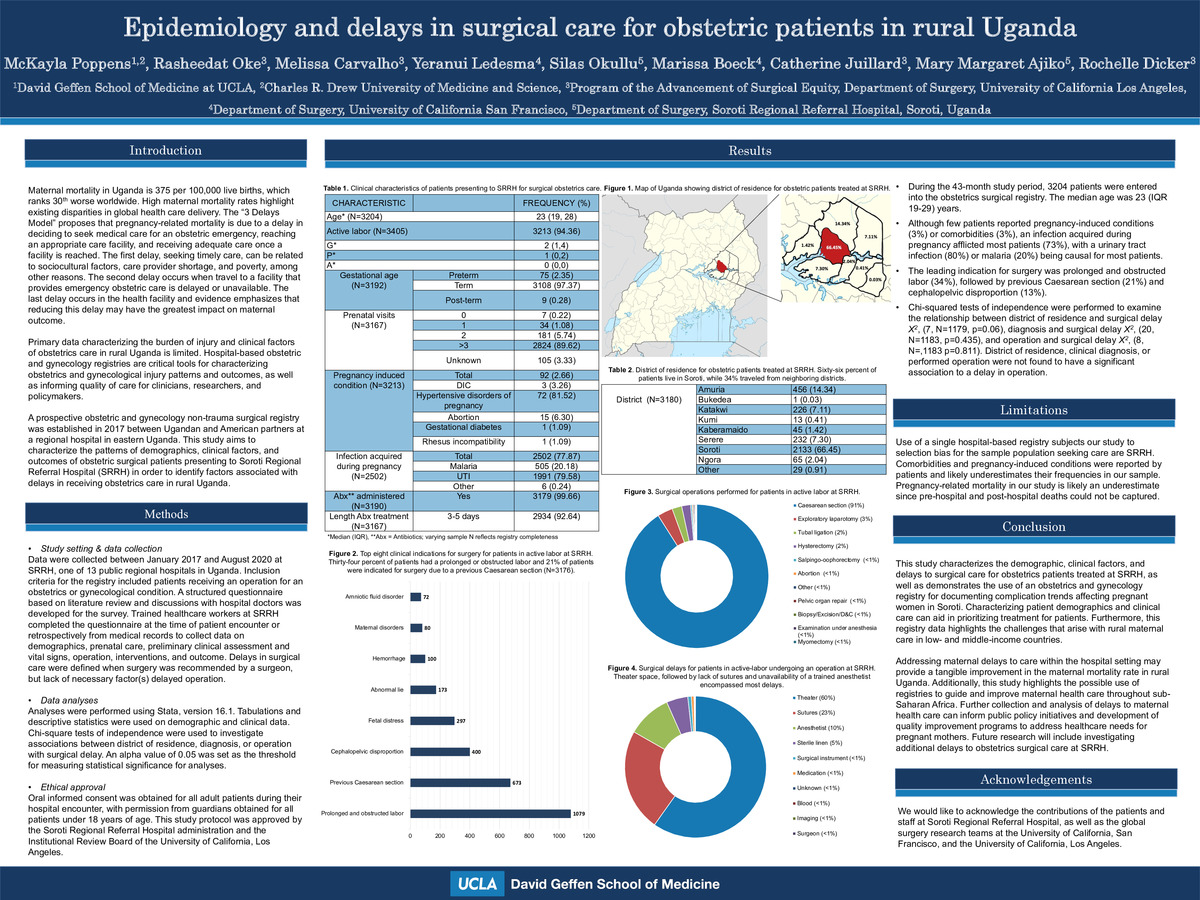-
Author
McKayla Poppens -
PI
Dr. Catherine Juillard & Dr. Rochelle Dicker
-
Co-Author
Rasheedat Oke, Melissa Carvalho, Yeranui Ledesma, Silas Okullu, Marissa Boeck, Catherine Juillard, Mary Margaret Ajiko, Rochelle Dicker
-
Title
Epidemiology and delays in surgical care for obstetric patients in rural Uganda
-
Program
Global Short-Term Training Program
-
Other Program (if not listed above)
-
Abstract
Background: Maternal mortality in Uganda is 375 per 100,000 live births, which ranks 30th worse worldwide. High maternal mortality rates highlight existing disparities in global health care delivery. The “3 Delays Model” proposes that pregnancy-related mortality is due to a delay in deciding to seek medical care for an obstetric emergency, reaching an appropriate care facility, and receiving adequate care once a facility is reached. Primary data characterizing the burden of injury and clinical factors of obstetric care in rural Uganda is limited. A prospective obstetrics and gynecology non-trauma surgical registry was established in 2017 between Ugandan and American partners at a regional hospital in eastern Uganda. This study aims to characterize the patterns of demographics, clinical factors, and outcomes of obstetric surgical patients presenting to Soroti Regional Referral Hospital (SRRH) in order to identify factors associated with delays in receiving obstetrics care in rural Uganda.
Methods: Data were collected between January 2017 and August 2020 at SRRH, one of 13 public regional hospitals in Uganda. Inclusion criteria for the registry included patients receiving an operation for an obstetrics or gynecological condition. A structured questionnaire based on literature review and discussions with hospital doctors was developed for the survey. Trained healthcare workers at SRRH completed the questionnaire at the time of patient encounter or retrospectively from medical records to collect data on demographics, prenatal care, preliminary clinical assessment and vital signs, operation, interventions, and outcome. Delays in surgical care were defined when surgery was recommended by a surgeon, but lack of necessary factor(s) delayed operation. Tabulations and descriptive statistics were used on demographic and clinical data. Chi-square tests of independence were used to investigate associations between district of residence, diagnosis, or operation with surgical delay.
Results: During the 43-month study period, 3204 patients were entered into the obstetrics surgical registry. The median age was 23 (IQR 19-29) years. Most patients were at term (97%) and in active labor (94%). Sixty-six percent of patients were residents of Soroti district. Almost 90% of patients received at least three prenatal visits. Although few patients reported pregnancy-induced conditions (3%) or comorbidities (3%), an infection acquired during pregnancy afflicted most patients (73%), with a urinary tract infection (80%) or malaria (20%) being causal for most patients. Antibiotics were administered to over 99% of patients in labor, with most patients’ treatment being 3-5 days. The leading indication for surgery was prolonged and obstructed labor (34%), followed by previous Caesarean section (21%) and cephalopelvic disproportion (13%). Nearly all patients (91%) underwent Caesarean section. Although the reported surgical complication rate was low (3%), most operations were reported to have at least one surgical delay (62%). Chi-squared tests of independence were performed to examine the relationship between district of residence and surgical delay X2 (7, N=1179, p=0.06), diagnosis and surgical delay X2 (20, N=1183, p=0.435), and operation and surgical delay X2 (8, N=,1183 p=0.811). District of residence, clinical diagnosis, or performed operation were not found to have a significant association with a delay in operation.
Conclusions and Relevance: This study characterizes the demographic, clinical factors, and delays to surgical care for obstetric patients treated at SRRH, as well as demonstrates the use of an obstetrics and gynecology registry for documenting complication trends affecting pregnant women in Soroti. Characterizing patient demographics and clinical care can aid in prioritizing treatment for patients. Furthermore, this registry data highlights the challenges that arise with rural maternal care in low- and middle-income countries. Addressing maternal delays to care within the hospital setting may provide a tangible improvement in the maternal mortality rate in rural Uganda. Additionally, this study highlights the possible use of registries to guide and improve maternal health care throughout sub-Saharan Africa. Further collection and analysis of delays to maternal health care can inform public policy initiatives and development of quality improvement programs to address healthcare needs for pregnant mothers.
-
PDF
-
Zoom

